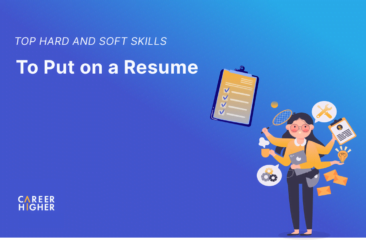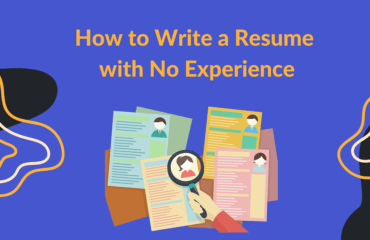Table of Contents
A video resume is a short introduction of a candidate’s relevant background, skills, and accomplishments for prospective employers in a video format. In most cases, it serves as a complement rather than a substitute to a traditional resume, bringing a candidate’s experience to life. As a result, it enables an employer to get a feel of an applicant’s personality and approach.
According to a study, viewers retain 95% of a message when they watch it in a video compared to 10% when reading it in text. So, by watching your resume instead of reading it, decision-makers are more likely to remember you. Keep reading to know how you can create a video resume that will help you outshine the competition.
When Should You Use a Video Resume?
Before digging your hands in, you need to know when to create a video resume. There are some fields like healthcare, banking, and legal that prefer a more traditional approach. For this reason, considering your target employer and industry is imperative. Below are some ideal scenarios where using a video resume could put a solid spin on your application.
- If the employer asks to provide a visual resume or an elevator pitch
- If you are applying for creative or client-facing roles such as media, fashion, sales, design, or IT
Types of Video Resume
If you consider yourself camera-shy, it’s not a problem. You can still create a video resume without talking in front of the camera. Here are other styles of video that you may use.
- Animation – This involves capturing sequential, static images, like drawings or photos of inanimate objects, and playing them in rapid succession to mimic real-world motion.
- Whiteboard video – This records an illustrated story using a whiteboard and is frequently aided by a narrated script.
- Stop-motion – This is a technique in which a camera is repeatedly stopped and started, frame-by-frame to provide inanimate objects and figures the impression of movement.
Video is one of the best ways to get your message across succinctly and effectively. As a rule of thumb, choose a style that best represents you and your qualifications. As long as you follow best practices, you are good to go.
Tips and Tricks for Making a Video Resume
Creating a video resume generally requires stage preparation and technical skills, like visual storytelling and editing. This makes it a bit more challenging than the traditional resume. In this section, we have outlined some of the tips and tricks you can follow to help you out in the process.
1) Create a script
Creating a script can help you organize your thoughts before recording. Additionally, it ensures you don’t miss essential qualifications you want to highlight. When writing your script, you also need to consider the entire length of your video. 90 to 120 seconds is typically the sweet spot to keep a viewer’s attention. Ideally, your narrative should include the following.
a) Introduction
The first few seconds of your video will create the employer’s first impression of you. For this reason, nailing your introduction is a must. Briefly introduce yourself and clearly state your intention. Your tone and body language should convey confidence, liveliness, and professionalism.
b) Unique Selling Points
This should detail what differentiates you from the competition. We recommend using a STAR (situation, task, action, result) format in structuring your narrative. This provides decision-makers with a fuller picture of what makes you a strong match for the position. You may use the following questions as a guide in crafting your story.
- What was the situation or your objective?
- What task did you need to accomplish? What obstacle or problem did you need to overcome?
- What were the actions are taken or skills you used?
- How did your effort benefit the company? What if you hadn’t taken that action? What was prevented
c) Keywords
You’ve probably heard the importance of keywords in resume writing. The same is true for creating a video resume. Incorporating some of the most important keywords from the job description can help maximize your application’s success because they match what the decision-makers seek.
d) Call to Action
A strong call to action summarizes a candidate’s qualification, spells out the next step, and prompts the viewers to act. For instance, you can reiterate what makes you a valuable addition to the company and politely ask the decision-makers to connect with you in an interview. Lastly, don’t forget to thank them for their time.
2) Find a good filming space
Now that your script is ready, it’s time to find a good filming space. This does not need to be a fancy recording studio. As long as the place has sufficient lighting, neutral background, and non-distracting noise, you should be all set for recording.
3) Set up recording equipment
A good quality video can help you set your application apart and allow it to outshine the competition. For this reason, choosing equipment that can record high-quality images and audio is essential. This can include a DSLR camera, laptop, or even your smartphone.
When setting up your equipment, make sure it fully captures your profile and action shots. You may use a tripod or any objects around your area that will keep your video’s focus in place. To ensure clear speech and audio, we recommend using good-quality headphones or microphones.
4) Dress professionally
Dressing professionally for a video resume is an essential aspect of making a positive impression. However, this does not automatically equate to suits and ties. You need to consider your target position, company, and industry when deciding what to wear.
If you’re applying for traditional organizations such as Finance and Legal, wearing something formal can be beneficial. On the other hand, business casual attire is recommended in more relaxed work environments like technical and retail. Dress in a way you want the decision-makers to remember you.
5) Record several takes
If you feel a little uncomfortable on camera, that’s normal, especially during your first few takes. Remember, you don’t need to get it perfectly on your first attempt. You can do as many takes as you like and select the best one.
When recording your video, play around with different expressions and vocal tones. Make sure you appear and sound engaged, comfortable, and confident throughout the video. We suggest splitting your recording into shorter segments so you can easily restart or try something new.
6) Edit the video
After recording your videos, review all the footage and choose the best ones. Then, put everything together based on the story you created. You may also consider adding elements like informational slides, infographics, photographs, or clippings to make your video more appealing. Here is a list of editing software you can use for a more efficient editing process.
7) Review your edited video and get back feedback
Before sending your video resume, review it a few times. Have you captured everything you’re meant to? Is the video clear and organized? Do you come across as professional, engaged, and confident? As they say, when in doubt, call a friend. In this case, we recommend asking a colleague, coworker, or consulting a career expert. These people can provide insights on any opportunities for improvement, allowing you to create the best video resume possible.
Have you ever wished you could tell employers what you can bring to the table instead of just writing it on paper? If yes, then a video resume is your opportunity to do so. But before deciding to go beyond the conventional approach, make sure it’s aligned with your target company and industry’s preference. We highly suggest submitting a video resume along with your traditional resume. If you need help writing your traditional resume, you can always reach out to us.











